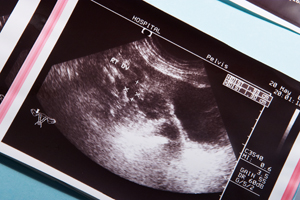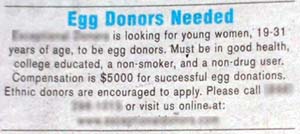|
Fertility clinics
and egg 'brokers' often pay young women thousands of dollars to
donate an egg. But what exactly does the process involve?
by Jen Schripsema and Sandrine
Ceurstemont

Representation
of a human egg before fertilization. Egg donation involves
removing eggs from a donor's ovaries and fertilizing them
in vitro.
|
|
With the rising cost of college tuition, many young people today are struggling to finance their education. Slaving away at a part-time job is one option, but advertisements in newspapers are publicizing an alternative for young women: donating an egg. Donors are offered between $3000 and $10,000 for a single egg, and for those with certain desirable traits- like race, appearance, high test scores, or athleticism - the compensation can be $20,000 or more. Figures like these can prove very tempting to a female student struggling to pay the bills. But what exactly does donating an egg involve?
Egg donation is more or less the female equivalent of sperm donation-only more complicated, risky, and lucrative. Every year, thousands of babies are born with the help of egg donations to women who, for a variety of reasons, cannot become pregnant using their own eggs. The process involves removing eggs from a donor's ovaries and fertilizing them in vitro. After being allowed to develop for a couple of days, three or four embryos are then implanted into the uterus of the woman who will mother the child.
The process is usually coordinated by fertility clinics or egg 'brokers', who often do the research and place the ads. It was after seeing one of these ads that Julia Derek considered becoming a donor. After finishing college when she was 24 years old, she approached a fertility clinic and since then became a twelve-time donor. She says that money was her main motivation for doing it - she was paid $3,500 per donation.
The screening process
Not just anybody can become a donor - interested women are subject to a lengthy screening process. In the first instance, Derek had to complete an application and attend an interview. "It was like a job interview," she says, "They want to make sure you're a normal person. I also had to fill out a 40 page questionnaire."

Pelvic ultrasound:
Potential egg donors may have to undergo a pelvic ultrasound
to determine if they will be a suitable donor.
|
If a donor makes it through this first stage, she will go through extensive medical and psychological screening including a pelvic exam, ultrasound, and blood tests for genetic conditions and infectious diseases, including sexually transmitted diseases (STDs). She will also be expected to provide a detailed medical and psychological history of herself and all of her close blood relatives.
Even after passing the initial screening, women can wait months before beginning the actual donation process. In most anonymous donations, the fertility clinic or egg broker will add them to a long list of potential donors waiting to be matched to recipients. Egg brokers only match donors and recipients; whereas fertility clinics also provide medical services.
Taking hormones
The medical treatment begins once donors are matched to recipients. First, a donor is prescribed birth control pills for a short time to put her menstrual cycle in sync with that of the recipient. She will then start daily injections of hormones intended to stimulate her ovaries into producing an overabundance of mature eggs. For the next three or four weeks, she must make frequent visits to the fertility clinic to determine when the eggs will be ready to be retrieved.
During the hormone treatment, there can be significant medical risks for the donor. Sex can sometimes be painful and dangerous since the ovaries are swollen with maturing eggs. Multiple pregnancies are also a strong possibility before the eggs are removed.
Derek says that the hormone treatment was the most uncomfortable part of the process. She was hyperstimulated since the hormones made her produce almost 30 eggs. "I was very bloated," she says. "It was often hard for me to lie down and sometimes even just breathing was uncomfortable. And my emotions were a mess."
About one in ten women will experience mild ovarian hyperstimulation syndrome (OHSS), a condition in which the hormone injections upset the body's fluid balance. Mild OHSS causes abdominal pain, diarrhea, and swelling. Approximately 1% of women will end up in the hospital with severe OHSS, which can cause kidney failure, fluid build-up in the lungs, and shock. Occasionally, OHSS can cause permanent infertility or death.
Even if no immediate problems are experienced, doctors don't know much about the long-term consequences of the hormone treatment, and some research has suggested that egg donors may have an increased risk of ovarian cancer.
Extracting the eggs
Once the eggs are ready to be extracted, donors are heavily sedated and 10-15 eggs are extracted with a large needle inserted into the ovary through the vaginal wall. Derek describes the egg retrieval as relatively easy and painless. The procedure takes about 30 minutes, and donors usually experience some pain and discomfort for a couple of days after the surgery. It took Derek about ten days to recover the first time, and she says that the recovery period was shorter for her subsequent donations.
But donating eggs multiple times did take its toll on Derek. After her ninth donation, she started to become depressed which she thinks was due to a hormonal imbalance caused by the hormone treatments. "The depression became more and more severe," she says. "It just got worse until I couldn't leave my bed and had to see a doctor. I believe it was linked to my repeated egg donations since there was nothing else going on in my life at the time that could have explained why I became so depressed."
An article in the Boston Globe
from June 2006 states that there is no government or industry group
that tracks how many times a woman has been an egg donor, although
The American Society for Reproductive Medicine has now set
guidelines recommending no more than six donations in a lifetime.
Scientists don't know if repeated donations have long-term effects
on a woman's fertility.

The United States is one of few industrialized countries that allows egg donors to be compensated.
|
The United States is one of very few industrialized countries that allows egg donors to be compensated. Since few women are willing to go through the process for free, finding acceptable eggs can be very difficult in other countries. Today, many European and Canadian couples travel to the U.S. for the sole reason of obtaining eggs for in vitro fertilization. The phenomenon has become so widespread that fertility clinics advertise for these "reproduction tourists."
This increased demand for eggs is also driving up the rate of donor compensation in the U.S. Many are concerned that paying donors, particularly very large amounts, causes young women desperate for money to agree to a procedure without fully understanding the risks involved. Many donors feel that they were not fully informed and have later regretted their decision to donate.
Now 35 years old, Derek says that her
decision to become a multiple donor was fuelled by the fact that
she was young and felt invincible. "I was a bit of a feminist, and
donating eggs made me feel empowered - I was spreading my genes,"
she says. "I would have benefited from more discussion about the
problems [associated with multiple donations]. I overdid it."
For more information:
New York State Department of Health - Becoming an Egg Donor
http://www.health.state.ny.us/nysdoh/infertility/eggdonor.htm
The Good Egg: An Ovum Donor's Journey
is a documentary about the personal experience of director Erin
Ploss-Campoamoror, who donated eggs at age 24:
http://goodegg.tv/
Confessions of a Serial Egg Donor
is a book written by Julia Derek about her experience as a twelve-time
egg donor:
http://www.amazon.com/gp/product/0974907901
|
